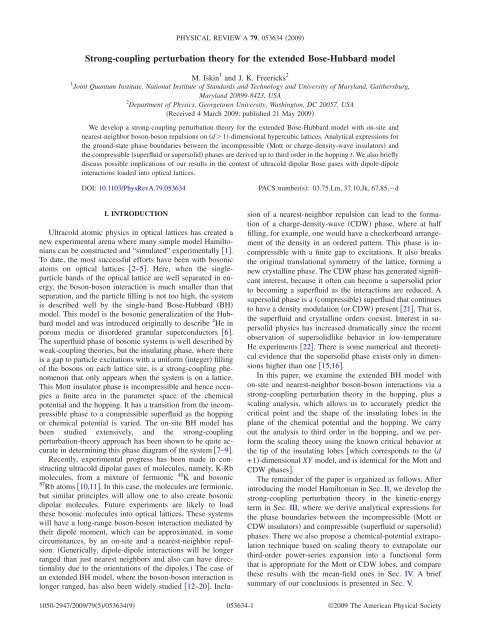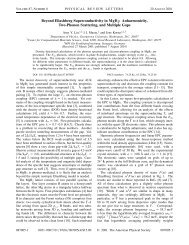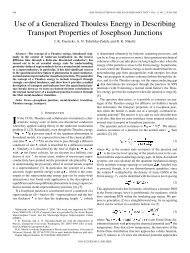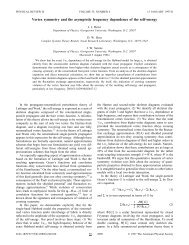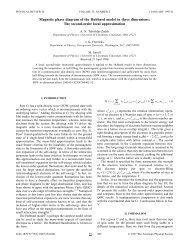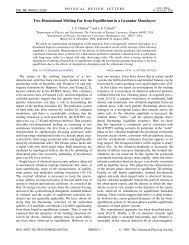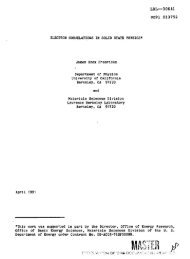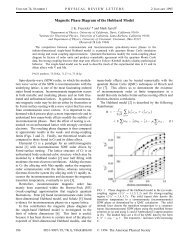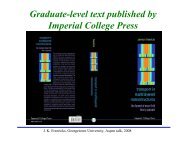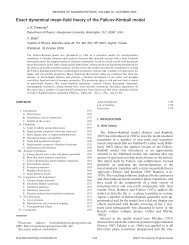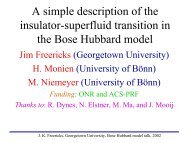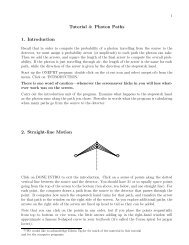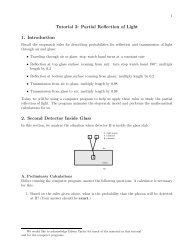Strong-coupling perturbation theory for the extended Bose-Hubbard ...
Strong-coupling perturbation theory for the extended Bose-Hubbard ...
Strong-coupling perturbation theory for the extended Bose-Hubbard ...
Create successful ePaper yourself
Turn your PDF publications into a flip-book with our unique Google optimized e-Paper software.
PHYSICAL REVIEW A 79, 053634 2009<br />
<strong>Strong</strong>-<strong>coupling</strong> <strong>perturbation</strong> <strong><strong>the</strong>ory</strong> <strong>for</strong> <strong>the</strong> <strong>extended</strong> <strong>Bose</strong>-<strong>Hubbard</strong> model<br />
M. Iskin 1 and J. K. Freericks 2<br />
1 Joint Quantum Institute, National Institute of Standards and Technology and University of Maryland, Gai<strong>the</strong>rsburg,<br />
Maryland 20899-8423, USA<br />
2 Department of Physics, Georgetown University, Washington, DC 20057, USA<br />
Received 4 March 2009; published 21 May 2009<br />
We develop a strong-<strong>coupling</strong> <strong>perturbation</strong> <strong><strong>the</strong>ory</strong> <strong>for</strong> <strong>the</strong> <strong>extended</strong> <strong>Bose</strong>-<strong>Hubbard</strong> model with on-site and<br />
nearest-neighbor boson-boson repulsions on d1-dimensional hypercubic lattices. Analytical expressions <strong>for</strong><br />
<strong>the</strong> ground-state phase boundaries between <strong>the</strong> incompressible Mott or charge-density-wave insulators and<br />
<strong>the</strong> compressible superfluid or supersolid phases are derived up to third order in <strong>the</strong> hopping t. We also briefly<br />
discuss possible implications of our results in <strong>the</strong> context of ultracold dipolar <strong>Bose</strong> gases with dipole-dipole<br />
interactions loaded into optical lattices.<br />
DOI: 10.1103/PhysRevA.79.053634<br />
PACS numbers: 03.75.Lm, 37.10.Jk, 67.85.d<br />
I. INTRODUCTION<br />
Ultracold atomic physics in optical lattices has created a<br />
new experimental arena where many simple model Hamiltonians<br />
can be constructed and “simulated” experimentally 1.<br />
To date, <strong>the</strong> most successful ef<strong>for</strong>ts have been with bosonic<br />
atoms on optical lattices 2–5. Here, when <strong>the</strong> singleparticle<br />
bands of <strong>the</strong> optical lattice are well separated in energy,<br />
<strong>the</strong> boson-boson interaction is much smaller than that<br />
separation, and <strong>the</strong> particle filling is not too high, <strong>the</strong> system<br />
is described well by <strong>the</strong> single-band <strong>Bose</strong>-<strong>Hubbard</strong> BH<br />
model. This model is <strong>the</strong> bosonic generalization of <strong>the</strong> <strong>Hubbard</strong><br />
model and was introduced originally to describe 4 He in<br />
porous media or disordered granular superconductors 6.<br />
The superfluid phase of bosonic systems is well described by<br />
weak-<strong>coupling</strong> <strong>the</strong>ories, but <strong>the</strong> insulating phase, where <strong>the</strong>re<br />
is a gap to particle excitations with a uni<strong>for</strong>m integer filling<br />
of <strong>the</strong> bosons on each lattice site, is a strong-<strong>coupling</strong> phenomenon<br />
that only appears when <strong>the</strong> system is on a lattice.<br />
This Mott insulator phase is incompressible and hence occupies<br />
a finite area in <strong>the</strong> parameter space of <strong>the</strong> chemical<br />
potential and <strong>the</strong> hopping. It has a transition from <strong>the</strong> incompressible<br />
phase to a compressible superfluid as <strong>the</strong> hopping<br />
or chemical potential is varied. The on-site BH model has<br />
been studied extensively, and <strong>the</strong> strong-<strong>coupling</strong><br />
<strong>perturbation</strong>-<strong><strong>the</strong>ory</strong> approach has been shown to be quite accurate<br />
in determining this phase diagram of <strong>the</strong> system 7–9.<br />
Recently, experimental progress has been made in constructing<br />
ultracold dipolar gases of molecules, namely, K-Rb<br />
molecules, from a mixture of fermionic 40 K and bosonic<br />
87 Rb atoms 10,11. In this case, <strong>the</strong> molecules are fermionic,<br />
but similar principles will allow one to also create bosonic<br />
dipolar molecules. Future experiments are likely to load<br />
<strong>the</strong>se bosonic molecules into optical lattices. These systems<br />
will have a long-range boson-boson interaction mediated by<br />
<strong>the</strong>ir dipole moment, which can be approximated, in some<br />
circumstances, by an on-site and a nearest-neighbor repulsion.<br />
Generically, dipole-dipole interactions will be longer<br />
ranged than just nearest neighbors and also can have directionality<br />
due to <strong>the</strong> orientations of <strong>the</strong> dipoles. The case of<br />
an <strong>extended</strong> BH model, where <strong>the</strong> boson-boson interaction is<br />
longer ranged, has also been widely studied 12–20. Inclusion<br />
of a nearest-neighbor repulsion can lead to <strong>the</strong> <strong>for</strong>mation<br />
of a charge-density-wave CDW phase, where at half<br />
filling, <strong>for</strong> example, one would have a checkerboard arrangement<br />
of <strong>the</strong> density in an ordered pattern. This phase is incompressible<br />
with a finite gap to excitations. It also breaks<br />
<strong>the</strong> original translational symmetry of <strong>the</strong> lattice, <strong>for</strong>ming a<br />
new crystalline phase. The CDW phase has generated significant<br />
interest, because it often can become a supersolid prior<br />
to becoming a superfluid as <strong>the</strong> interactions are reduced. A<br />
supersolid phase is a compressible superfluid that continues<br />
to have a density modulation or CDW present 21. That is,<br />
<strong>the</strong> superfluid and crystalline orders coexist. Interest in supersolid<br />
physics has increased dramatically since <strong>the</strong> recent<br />
observation of supersolidlike behavior in low-temperature<br />
He experiments 22. There is some numerical and <strong>the</strong>oretical<br />
evidence that <strong>the</strong> supersolid phase exists only in dimensions<br />
higher than one 15,16.<br />
In this paper, we examine <strong>the</strong> <strong>extended</strong> BH model with<br />
on-site and nearest-neighbor boson-boson interactions via a<br />
strong-<strong>coupling</strong> <strong>perturbation</strong> <strong><strong>the</strong>ory</strong> in <strong>the</strong> hopping, plus a<br />
scaling analysis, which allows us to accurately predict <strong>the</strong><br />
critical point and <strong>the</strong> shape of <strong>the</strong> insulating lobes in <strong>the</strong><br />
plane of <strong>the</strong> chemical potential and <strong>the</strong> hopping. We carry<br />
out <strong>the</strong> analysis to third order in <strong>the</strong> hopping, and we per<strong>for</strong>m<br />
<strong>the</strong> scaling <strong><strong>the</strong>ory</strong> using <strong>the</strong> known critical behavior at<br />
<strong>the</strong> tip of <strong>the</strong> insulating lobes which corresponds to <strong>the</strong> d<br />
+1-dimensional XY model, and is identical <strong>for</strong> <strong>the</strong> Mott and<br />
CDW phases.<br />
The remainder of <strong>the</strong> paper is organized as follows. After<br />
introducing <strong>the</strong> model Hamiltonian in Sec. II, we develop <strong>the</strong><br />
strong-<strong>coupling</strong> <strong>perturbation</strong> <strong><strong>the</strong>ory</strong> in <strong>the</strong> kinetic-energy<br />
term in Sec. III, where we derive analytical expressions <strong>for</strong><br />
<strong>the</strong> phase boundaries between <strong>the</strong> incompressible Mott or<br />
CDW insulators and compressible superfluid or supersolid<br />
phases. There we also propose a chemical-potential extrapolation<br />
technique based on scaling <strong><strong>the</strong>ory</strong> to extrapolate our<br />
third-order power-series expansion into a functional <strong>for</strong>m<br />
that is appropriate <strong>for</strong> <strong>the</strong> Mott or CDW lobes, and compare<br />
<strong>the</strong>se results with <strong>the</strong> mean-field ones in Sec. IV. A brief<br />
summary of our conclusions is presented in Sec. V.<br />
1050-2947/2009/795/0536349<br />
053634-1<br />
©2009 The American Physical Society
M. ISKIN AND J. K. FREERICKS PHYSICAL REVIEW A 79, 053634 2009<br />
II. EXTENDED BOSE-HUBBARD MODEL<br />
We consider <strong>the</strong> following <strong>extended</strong> BH Hamiltonian with<br />
on-site and nearest-neighbor boson-boson repulsions:<br />
H =− t ij b † i b j + U <br />
i,j 2 i<br />
nˆ inˆ i −1 + <br />
i,j<br />
V ij nˆ inˆ j − nˆ i,<br />
i<br />
1<br />
where t ij is <strong>the</strong> tunneling or hopping matrix elements between<br />
sites i and j, b † i b i is <strong>the</strong> boson creation annihilation<br />
operator at site i, nˆ i=b † i b i is <strong>the</strong> boson number operator, U<br />
0 is <strong>the</strong> strength of <strong>the</strong> on-site repulsion and V ij is <strong>the</strong><br />
longer-ranged boson-boson repulsion between bosons at sites<br />
i and j, and is <strong>the</strong> chemical potential. In this paper, we<br />
assume t ij is a real symmetric matrix with elements t ij =t <strong>for</strong><br />
i and j nearest neighbors and 0 o<strong>the</strong>rwise and similarly <strong>for</strong><br />
V ij equal to V0 <strong>for</strong> i and j nearest neighbors and zero<br />
o<strong>the</strong>rwise, and consider a d1-dimensional hypercubic<br />
lattice with M sites 23. Note that we work on a periodic<br />
lattice with no external trap potential.<br />
We also assume UzV, where z=2d is <strong>the</strong> lattice coordination<br />
number number of nearest neighbors. In this case,<br />
<strong>the</strong> boson occupancy of <strong>the</strong> nearest-neighbor sites in <strong>the</strong><br />
CDW phase can only differ by 1. For instance, <strong>the</strong> first CDW<br />
phase is such that every o<strong>the</strong>r site is occupied by one boson<br />
and <strong>the</strong> remaining sites are left unoccupied. When UzV,<br />
additional CDW phases can be present in <strong>the</strong> phase diagram.<br />
For instance, a CDW phase in which every o<strong>the</strong>r site is occupied<br />
by two bosons and <strong>the</strong> remaining sites are left unoccupied<br />
is energetically more favorable than a Mott phase in<br />
which every lattice site is occupied by one boson. Our results,<br />
with minor changes, can also be used to analyze <strong>the</strong>se<br />
additional CDW phases if desired, but more work would be<br />
needed to examine o<strong>the</strong>r types of CDW order, such as columnar<br />
stripes, which can arise from longer-range interactions.<br />
A. Atomic (t=0) limit<br />
To understand <strong>the</strong> zero-temperature T=0 phase diagram<br />
of <strong>the</strong> <strong>extended</strong> BH model given in Eq. 1, we start by<br />
analyzing <strong>the</strong> atomic t=0 limit. In this limit, since <strong>the</strong> kinetic<br />
energy vanishes, <strong>the</strong> boson number operator nˆ i commutes<br />
with all of <strong>the</strong> remaining terms of <strong>the</strong> Hamiltonian.<br />
There<strong>for</strong>e, every lattice site is occupied by a fixed number n i<br />
of bosons and <strong>the</strong> system is insulating.<br />
When V=0, <strong>the</strong> ground-state boson occupancy is <strong>the</strong> same<br />
<strong>for</strong> every lattice site such that nˆ i=n 0 , where ¯ is <strong>the</strong><br />
<strong>the</strong>rmal average, and <strong>the</strong> average boson occupancy n 0 is chosen<br />
to minimize <strong>the</strong> ground-state energy <strong>for</strong> a given . The<br />
symbol n 0 is an integer here and should not be confused with<br />
<strong>the</strong> condensate fraction of a superfluid. It turns out that <strong>the</strong><br />
ground-state energy of <strong>the</strong> n 0 state is degenerate with that of<br />
<strong>the</strong> n 0 +1 state at =Un 0 . This means that <strong>the</strong> chemicalpotential<br />
width of all Mott lobes is U, and that <strong>the</strong> boson<br />
occupancy increases from n 0 to n 0 +1 when =Un 0 +0 + . For<br />
instance, <strong>the</strong> ground state is a vacuum with n 0 =0 <strong>for</strong> 0;<br />
it is a Mott insulator with n 0 =1 <strong>for</strong> 0U; it is a Mott<br />
insulator with n 0 =2 <strong>for</strong> U2U; and so on.<br />
When V0, <strong>the</strong> ground state has an additional CDW<br />
phase which has crystalline order in <strong>the</strong> <strong>for</strong>m of staggered<br />
boson densities, i.e., nˆ i=n A and nˆ j=n B <strong>for</strong> i and j nearest<br />
neighbors. There<strong>for</strong>e, to describe <strong>the</strong> CDW phases, it is convenient<br />
to split <strong>the</strong> entire lattice into two sublattices A and B<br />
such that <strong>the</strong> nearest-neighbor sites belong to a different sublattice.<br />
A lattice <strong>for</strong> which this can be done is called a bipartite<br />
lattice—we assume <strong>the</strong> number of lattice sites in each<br />
sublattice is <strong>the</strong> same here. We assume that <strong>the</strong> boson occupancies<br />
of sublattices A and B are n A and n B , respectively,<br />
such that n A n B . We remark that <strong>the</strong> n A =n B =n 0 states correspond<br />
to <strong>the</strong> Mott phase. It turns out that <strong>the</strong> ground-state<br />
energy of <strong>the</strong> n A =n 0 +1, n B =n 0 state is degenerate with<br />
those of <strong>the</strong> n A =n 0 , n B =n 0 and n A =n 0 +1, n B =n 0 +1<br />
states at =Un 0 +zVn 0 and =Un 0 +zVn 0 +1, respectively.<br />
This means that <strong>the</strong> chemical-potential width of all Mott and<br />
CDW lobes are U and zV, respectively, and that <strong>the</strong> ground<br />
state alternates between <strong>the</strong> CDW and Mott phases as a function<br />
of increasing . For instance, <strong>the</strong> ground state is a<br />
vacuum n A =0, n B =0 <strong>for</strong> 0; it is a CDW with<br />
n A =1, n B =0 <strong>for</strong> 0zV; it is a Mott insulator with<br />
n A =1, n B =1 <strong>for</strong> zVU+zV; it is a CDW with<br />
n A =2, n B =1 <strong>for</strong> U+zVU+2zV; it is a Mott insulator<br />
with n A =2, n B =2 <strong>for</strong> U+2zV2U+2zV; and so<br />
on.<br />
Having discussed <strong>the</strong> t=0 limit, now we are ready to analyze<br />
<strong>the</strong> competition between <strong>the</strong> kinetic- and potentialenergy<br />
terms of <strong>the</strong> Hamiltonian when t0. As t increases,<br />
one expects that <strong>the</strong> range of about which <strong>the</strong> ground state<br />
is insulating incompressible decreases, and that <strong>the</strong> Mott<br />
and CDW phases disappear at a critical value of t, beyond<br />
which <strong>the</strong> system becomes compressible.<br />
B. Transition from an incompressible to a compressible phase<br />
To determine <strong>the</strong> phase boundary between <strong>the</strong> incompressible<br />
Mott or CDW insulators and <strong>the</strong> compressible<br />
superfluid or supersolid phases, we need <strong>the</strong> energies of <strong>the</strong><br />
Mott and CDW phases and of <strong>the</strong>ir defect states as functions<br />
of t. The defect states are characterized by exactly one extra<br />
particle or hole which moves coherently throughout <strong>the</strong> lattice.<br />
At <strong>the</strong> point where <strong>the</strong> energy of <strong>the</strong> incompressible<br />
state becomes degenerate with its defect state, <strong>the</strong> system<br />
becomes compressible assuming that <strong>the</strong> compressibility approaches<br />
zero continuously at <strong>the</strong> phase boundary. There<strong>for</strong>e,<br />
<strong>the</strong> phase boundary between <strong>the</strong> Mott and superfluid phases<br />
is determined by<br />
E ins<br />
Mott<br />
E ins<br />
Mott<br />
par<br />
n 0 = E Mott n 0 ,<br />
hol<br />
n 0 = E Mott n 0 ,<br />
where E ins Mott n 0 is <strong>the</strong> energy of <strong>the</strong> Mott phase with n 0<br />
par<br />
hol<br />
bosons on every lattice site, and E Mott n 0 and E Mott n 0 are<br />
<strong>the</strong> energies of <strong>the</strong> Mott-defect phases with exactly one extra<br />
particle or hole, respectively. These conditions determine <strong>the</strong><br />
phase boundaries of <strong>the</strong> particle and hole branches of <strong>the</strong><br />
par hol<br />
Mott insulating lobes, Mott and Mott , respectively, as functions<br />
of t, U, V, and n 0 . Similarly <strong>the</strong> phase boundary between<br />
<strong>the</strong> CDW and supersolid phases is determined by<br />
2<br />
3<br />
053634-2
STRONG-COUPLING PERTURBATION THEORY FOR THE…<br />
PHYSICAL REVIEW A 79, 053634 2009<br />
ins<br />
E CDW<br />
ins<br />
E CDW<br />
par<br />
n A ,n B = E CDW n A ,n B ,<br />
hol<br />
n A ,n B = E CDW n A ,n B ,<br />
ins<br />
where E CDW n A ,n B is <strong>the</strong> energy of <strong>the</strong> CDW phase with n A<br />
par<br />
and n B bosons on alternating lattice sites, and E CDW n A ,n B <br />
hol<br />
and E CDW n A ,n B are <strong>the</strong> energies of <strong>the</strong> CDW-defect phases<br />
with exactly one extra particle or hole, respectively. These<br />
conditions determine <strong>the</strong> phase boundaries of <strong>the</strong> particle and<br />
par hol<br />
hole branches of <strong>the</strong> CDW insulating lobes, CDW and CDW ,<br />
respectively, as functions of t, U, V, n A , and n B . Next, we<br />
calculate <strong>the</strong> energies of <strong>the</strong> Mott and CDW phases and of<br />
<strong>the</strong>ir defect states as a perturbative series in <strong>the</strong> hopping t.<br />
III. STRONG-COUPLING PERTURBATION THEORY<br />
We use <strong>the</strong> many-body version of Rayleigh-Schrödinger<br />
<strong>perturbation</strong> <strong><strong>the</strong>ory</strong> in <strong>the</strong> kinetic-energy term 24 to per<strong>for</strong>m<br />
<strong>the</strong> expansion in powers of <strong>the</strong> hopping <strong>for</strong> <strong>the</strong> different<br />
energies needed to carry out our analysis. The <strong>perturbation</strong><br />
<strong><strong>the</strong>ory</strong> is per<strong>for</strong>med with respect to <strong>the</strong> ground state of<br />
<strong>the</strong> system when <strong>the</strong> kinetic-energy term is absent. This technique<br />
was previously used to discuss <strong>the</strong> phase diagram of<br />
<strong>the</strong> on-site BH model 7,8, and its results showed excellent<br />
agreement with <strong>the</strong> quantum Monte Carlo simulations including<br />
<strong>the</strong> most recent numerical work 25,26. Here, we<br />
generalize this method to <strong>the</strong> <strong>extended</strong> BH model, hoping to<br />
develop an analytical approach which could also be as accurate<br />
as <strong>the</strong> numerical ones. However, we remark that our<br />
strong-<strong>coupling</strong> <strong>perturbation</strong> <strong><strong>the</strong>ory</strong> cannot be used to calculate<br />
<strong>the</strong> phase boundary between two compressible phases,<br />
e.g., <strong>the</strong> supersolid-to-superfluid transition. In addition, we<br />
cannot even tell whe<strong>the</strong>r <strong>the</strong> compressible phase is a supersolid<br />
or a superfluid.<br />
A. Ground-state wave functions at zeroth order in t<br />
For our purpose, we first need <strong>the</strong> ground-state wave<br />
functions of <strong>the</strong> Mott and CDW phases and of <strong>the</strong>ir particle<br />
and hole defects when t=0. To zeroth order in t, <strong>the</strong> Mott and<br />
CDW wave functions can be written as<br />
M ins0 bk<br />
= <br />
† n 0<br />
n0 ! 0,<br />
Mott<br />
ins0 CDW =<br />
k=1<br />
M/2<br />
<br />
iA,jB<br />
b † i n A b † j n B<br />
nA ! nB ! 0,<br />
where M is <strong>the</strong> number of lattice sites, and 0 is <strong>the</strong> vacuum<br />
state here, we recall that <strong>the</strong> lattice is divided equally into A<br />
and B sublattices. We use here and throughout <strong>the</strong> index k to<br />
refer to all lattice sites, while <strong>the</strong> indices i and j are limited to<br />
<strong>the</strong> A and B sublattices, respectively.<br />
On <strong>the</strong> o<strong>the</strong>r hand, <strong>the</strong> wave functions of <strong>the</strong> defect states<br />
are determined by degenerate <strong>perturbation</strong> <strong><strong>the</strong>ory</strong>. To zeroth<br />
order in t, <strong>the</strong> wave functions <strong>for</strong> <strong>the</strong> particle-defect states<br />
can be written as<br />
par0 Mott =<br />
1<br />
M<br />
f Mott k b † k ins0 Mott ,<br />
n0 +1k=1<br />
4<br />
5<br />
6<br />
7<br />
8<br />
par0 CDW =<br />
M/2<br />
1<br />
f CDWB j b † j ins0 CDW ,<br />
nB +1jB<br />
where f Mott k is <strong>the</strong> eigenvector of <strong>the</strong> hopping matrix t kk with<br />
Mott<br />
<strong>the</strong> highest eigenvalue which is zt such that k t kk f k<br />
=ztf Mott k , and f CDWB j is <strong>the</strong> eigenvector of i t ji t ij this matrix<br />
lives solely on <strong>the</strong> B sublattice with <strong>the</strong> highest eigenvalue<br />
which is z 2 t 2 such that ij t ji t ij f CDWB j =z 2 t 2 f CDWB j . Notice<br />
that we choose <strong>the</strong> highest eigenvalue of t ij because <strong>the</strong> hopping<br />
matrix enters <strong>the</strong> Hamiltonian as −t ij , and we ultimately<br />
want <strong>the</strong> lowest-energy states. Similarly <strong>for</strong> <strong>the</strong> CDW<br />
phases, <strong>the</strong> coefficient of <strong>the</strong> t 2 matrix that enters <strong>the</strong><br />
<strong>perturbation</strong> <strong><strong>the</strong>ory</strong> is negative, so we want <strong>the</strong> highest<br />
eigenvalue again. The normalization condition requires that<br />
M k=1 f Mott k 2 =1 and M/2 jB f CDWB j 2 =1. Similarly, to zeroth order<br />
in t, <strong>the</strong> wave functions <strong>for</strong> <strong>the</strong> hole-defect states can be<br />
written as<br />
hol0 Mott = 1<br />
hol0 CDW = 1<br />
M<br />
n0<br />
<br />
k=1<br />
M/2<br />
nA<br />
<br />
iA<br />
f Mott k b k ins0 Mott ,<br />
f CDWA i b i ins0 CDW ,<br />
9<br />
10<br />
11<br />
where f CDWA i is <strong>the</strong> eigenvector of j t ij t ji this matrix lives<br />
solely on <strong>the</strong> A sublattice with <strong>the</strong> highest eigenvalue<br />
which is z 2 t 2 such that ji t ij t ji f CDWA i =z 2 t 2 f CDWA i . The normalization<br />
condition requires that M/2 iA f CDWA i 2 =1.<br />
B. Ground-state energies up to third order in t<br />
Next, we employ <strong>the</strong> many-body version of Rayleigh-<br />
Schrödinger <strong>perturbation</strong> <strong><strong>the</strong>ory</strong> in t with respect to <strong>the</strong><br />
ground state of <strong>the</strong> system when t=0, and calculate <strong>the</strong> energies<br />
of <strong>the</strong> Mott and CDW phases and of <strong>the</strong>ir particle- and<br />
hole-defect states. To third order in t, <strong>the</strong> energy of <strong>the</strong> Mott<br />
state is obtained via nondegenerate <strong>perturbation</strong> <strong><strong>the</strong>ory</strong> and it<br />
is given by<br />
E ins<br />
Mott n 0 <br />
= U n 0n 0 −1<br />
+ zV n 0 2<br />
M<br />
2 2 − n zt 2<br />
0 − n 0 n 0 +1<br />
U − V<br />
+ Ot 4 , 12<br />
which is an extensive quantity, that is, E ins<br />
Mott n 0 is proportional<br />
to <strong>the</strong> total number of lattice sites M. The odd-order<br />
terms in t vanish <strong>for</strong> <strong>the</strong> d-dimensional hypercubic lattices<br />
considered in this paper; <strong>the</strong>y enter on nonbipartite lattices<br />
such as <strong>the</strong> triangular lattice. Notice that Eq. 12 recovers<br />
<strong>the</strong> known result <strong>for</strong> <strong>the</strong> on-site BH model when V=0 7,8.<br />
Similarly, to third order in t, <strong>the</strong> energy of <strong>the</strong> CDW state is<br />
also obtained via nondegenerate <strong>perturbation</strong> <strong><strong>the</strong>ory</strong> and it<br />
can be written as<br />
053634-3
M. ISKIN AND J. K. FREERICKS PHYSICAL REVIEW A 79, 053634 2009<br />
ins<br />
E CDW n A ,n B <br />
= U n An A −1 + n B n B −1<br />
+ zV n An B<br />
− n A + n B<br />
M<br />
4<br />
2 2<br />
n<br />
+<br />
A n B +1<br />
Un A − n B −1 + Vzn B − zn A +1 + n B n A +1<br />
Un B − n A −1 + Vzn A − zn B +1 zt2<br />
2 + Ot4 , 13<br />
which is also an extensive quantity, and <strong>the</strong> odd-order terms in t also vanish. Notice that Eq. 13 reduces to Eq. 12 when<br />
n A =n B =n 0 as expected.<br />
The calculation of <strong>the</strong> defect state energies is more involved since it requires using degenerate <strong>perturbation</strong> <strong><strong>the</strong>ory</strong>. This is<br />
because when exactly one extra particle or hole is added to <strong>the</strong> Mott phase, it could go to any of <strong>the</strong> M lattice sites and all of<br />
those states share <strong>the</strong> same energy when t=0. There<strong>for</strong>e, <strong>for</strong> both Mott-defect states with exactly one extra particle or hole, <strong>the</strong><br />
initial degeneracy is of order M and it is lifted at first order in t. A lengthy but straight<strong>for</strong>ward calculation leads to <strong>the</strong> energy<br />
of <strong>the</strong> Mott particle-defect state up to third order in t as<br />
par<br />
E Mott<br />
n 0 = E ins<br />
Mott n 0 + Un 0 + zVn 0 − − n 0 +1zt + n 0n 0 +1 1−z<br />
U<br />
n 0 z −2<br />
U 2 + z2 −3z +3 U − V 2<br />
+ 21−z<br />
U −2V +<br />
2z<br />
U − V − n 0 +2<br />
2U − Vzt 2 − n 0 n 0 +1<br />
+ n 0 +1 z1−z<br />
U 2 − 2z2 −6z +6<br />
U − V 2 + 2z1−z<br />
U −2V 2 + 2z2 −3z +3<br />
+<br />
UU − V<br />
+ 4z2 −3z +3<br />
+ n<br />
U − VU −2V 0 +2 z −1<br />
UU − V − z<br />
4U − V 2zt3 + Ot 4 .<br />
4z −2<br />
UU −2V<br />
14<br />
This expression is valid <strong>for</strong> all d-dimensional hypercubic lattices, and it recovers <strong>the</strong> known result <strong>for</strong> <strong>the</strong> on-site BH model<br />
when V=0 7,8. To third order in t, we obtain a similar expression <strong>for</strong> <strong>the</strong> energy of <strong>the</strong> Mott hole-defect state given by<br />
hol<br />
E Mott<br />
n 0 = E ins<br />
Mott n 0 − Un 0 −1 − zVn 0 + − n 0 zt + n 0 +1n 0 1−z<br />
U<br />
− n 0 n 0 +1n 0 +1 z −2<br />
U 2 + z2 −3z +3 U − V 2<br />
+ 21−z<br />
U −2V +<br />
+ 4z2 −3z +3<br />
+ n<br />
U − VU −2V 0 −1 z −1<br />
UU − V − z<br />
4U − V 2zt3 + Ot 4 ,<br />
2z<br />
U − V −<br />
n 0 −1<br />
2U − Vzt 2<br />
+ n 0 z1−z<br />
U 2 − 2z2 −6z +6<br />
U − V 2 + 2z1−z<br />
U −2V 2 + 2z2 −3z +3<br />
+<br />
UU − V<br />
4z −2<br />
UU −2V<br />
15<br />
which also is valid <strong>for</strong> all d-dimensional hypercubic lattices, and recovers <strong>the</strong> known result <strong>for</strong> <strong>the</strong> on-site BH model when<br />
V=0 7,8.<br />
On <strong>the</strong> o<strong>the</strong>r hand, <strong>for</strong> d1 dimensions, when an extra particle or hole is added to <strong>the</strong> CDW phase, it could go to any of<br />
<strong>the</strong> M /2 sites in sublattice B or A, respectively. Here, we recall that n A n B is assumed in this paper. There<strong>for</strong>e, <strong>for</strong> both<br />
CDW-defect states with an extra particle or hole in d1 dimensions, <strong>the</strong> degeneracy is of order M /2 and it is lifted at second<br />
order in t. This is because <strong>the</strong> states occupy one of <strong>the</strong> sublattices, and <strong>the</strong>y cannot be connected by one hop, but ra<strong>the</strong>r require<br />
two hops to be connected. Ano<strong>the</strong>r lengthy but straight<strong>for</strong>ward calculation leads to <strong>the</strong> energy of <strong>the</strong> CDW particle-defect state<br />
up to third order in t as<br />
par<br />
E CDW<br />
ins<br />
n A ,n B = E CDW<br />
−<br />
+<br />
n A ,n B + Un B + zVn A − +<br />
n A +1n B +1z<br />
Un B − n A + Vzn A − zn B − n A n B +1z<br />
Un A − n B −1 + Vzn B − zn A +1<br />
n B n A +1z<br />
Un B − n A −1 + Vzn A − zn B +1 + n A n B +2<br />
Un A − n B −2 + Vzn B − zn A +2 +<br />
2n A n B +1z −1<br />
Un A − n B −1 + Vzn B − zn A +2zt 2 + Ot 4 .<br />
n B n A +1z −1<br />
Un B − n A −1 + Vzn A − zn B <br />
16<br />
This expression is valid <strong>for</strong> d1-dimensional hypercubic lattices. Notice that <strong>the</strong> odd-order terms in t vanish <strong>for</strong> <strong>the</strong>se<br />
lattices. To third order in t, we obtain a similar expression <strong>for</strong> <strong>the</strong> energy of <strong>the</strong> CDW hole-defect state given by<br />
053634-4
STRONG-COUPLING PERTURBATION THEORY FOR THE…<br />
hol<br />
E CDW<br />
ins<br />
n A ,n B = E CDW<br />
−<br />
+<br />
n A ,n B − Un A −1 − zVn B + +<br />
n A n B z<br />
Un B − n A + Vzn A − zn B − n A n B +1z<br />
Un A − n B −1 + Vzn B − zn A +1<br />
n B n A +1z<br />
Un B − n A −1 + Vzn A − zn B +1 + n A −1n B +1<br />
Un A − n B −2 + Vzn B − zn A +2 +<br />
2n A n B +1z −1<br />
Un A − n B −1 + Vzn B − zn A +2zt 2 + Ot 4 .<br />
PHYSICAL REVIEW A 79, 053634 2009<br />
n B n A +1z −1<br />
Un B − n A −1 + Vzn A − zn B <br />
17<br />
This expression is also valid <strong>for</strong> d1-dimensional hypercubic<br />
lattices where <strong>the</strong> odd-order terms in t vanish.<br />
Notice that because <strong>the</strong> Mott-defect states have corrections<br />
to first order in <strong>the</strong> hopping, while <strong>the</strong> CDW defects<br />
have corrections to second order in <strong>the</strong> hopping, <strong>the</strong> slopes of<br />
<strong>the</strong> Mott phase will be finite as t→0, but <strong>the</strong>y will vanish <strong>for</strong><br />
<strong>the</strong> CDW lobes. Hence, <strong>the</strong> shapes of <strong>the</strong> different types of<br />
insulating lobes are always different.<br />
In one dimension d=1, however, when exactly one extra<br />
particle or hole is added to <strong>the</strong> CDW phase, <strong>the</strong> degeneracy<br />
of both of <strong>the</strong> CDW-defect states is of order M /2 2 and it is<br />
lifted at first order in t. This difference between d1 and<br />
d=1 makes one dimension unique, and it is <strong>the</strong> reason that<br />
<strong>the</strong> supersolid phase exists in higher dimensions but not in<br />
one 15,16. In o<strong>the</strong>r words, due to this large degeneracy, an<br />
extra particle or hole immediately delocalizes <strong>the</strong> bosons in<br />
d=1, and <strong>the</strong> crystalline order disappears. Since d=1 requires<br />
special attention, it will be addressed elsewhere, and<br />
we restrict <strong>the</strong> analysis here to higher dimensions.<br />
We would like to remark in passing that <strong>the</strong> energy difference<br />
between <strong>the</strong> Mott and CDW phases with <strong>the</strong>ir defect<br />
states determine <strong>the</strong> phase boundary of <strong>the</strong> particle and hole<br />
branches. While all E ins par<br />
hol<br />
Mott n 0 , E Mott n 0 , and E Mott n 0 depend<br />
on <strong>the</strong> lattice size M, <strong>the</strong>ir difference does not. There<strong>for</strong>e, <strong>the</strong><br />
chemical potentials that determine <strong>the</strong> particle and hole<br />
par hol<br />
branches, Mott and Mott , respectively, are independent of M<br />
ins<br />
at <strong>the</strong> phase boundaries. Similarly, while all E CDW n A ,n B ,<br />
par<br />
hol<br />
E CDW n A ,n B , and E CDW n A ,n B depend also on <strong>the</strong> lattice<br />
size M, <strong>the</strong>ir difference does not. There<strong>for</strong>e, <strong>the</strong> chemical<br />
potentials that determine <strong>the</strong> particle and hole branches,<br />
par<br />
hol<br />
CDW and CDW , respectively, are also independent of M at<br />
<strong>the</strong> phase boundaries. These observations indicate that <strong>the</strong><br />
numerical quantum Monte Carlo simulations which are<br />
based on Eqs. 2–5 should not have too strong a dependence<br />
on M. It also shows that exact diagonalization on finite<br />
clusters of a sufficiently large size can also yield <strong>the</strong>se expressions<br />
if properly analyzed to extract <strong>the</strong> coefficients of<br />
<strong>the</strong> power series.<br />
C. Extrapolation to infinite order via scaling <strong><strong>the</strong>ory</strong><br />
As a general rule, <strong>the</strong> third-order strong-<strong>coupling</strong> <strong>perturbation</strong><br />
<strong><strong>the</strong>ory</strong> appears to be more accurate in lower dimensions.<br />
For this reason, an extrapolation technique to infinite<br />
order in t is highly desirable to determine more accurate<br />
phase diagrams. Here, we propose a chemical-potential extrapolation<br />
technique based on scaling <strong><strong>the</strong>ory</strong> to extrapolate<br />
our third-order power-series expansion into a functional <strong>for</strong>m<br />
that is appropriate <strong>for</strong> <strong>the</strong> Mott and CDW lobes.<br />
It is known that <strong>the</strong> critical point at <strong>the</strong> tip of <strong>the</strong> Mott and<br />
CDW lobes has <strong>the</strong> scaling behavior of a d+1-dimensional<br />
XY model, and <strong>the</strong>re<strong>for</strong>e <strong>the</strong> lobes have Kosterlitz-Thouless<br />
shapes <strong>for</strong> d=1 and power-law shapes <strong>for</strong> d1. For <strong>the</strong> latter<br />
case considered in this paper, we propose <strong>the</strong> following<br />
ansatz <strong>for</strong> <strong>the</strong> Mott and CDW lobes which includes <strong>the</strong><br />
known power-law critical behavior of <strong>the</strong> tip of <strong>the</strong> lobes<br />
par,hol<br />
Mott,CDW<br />
U<br />
c<br />
= A Mott,CDW x B Mott,CDW xx Mott,CDW − x z ,<br />
18<br />
where A Mott,CDW x=a Mott,CDW +b Mott,CDW x+c Mott,CDW x 2<br />
+d Mott,CDW x 3 +¯ and B Mott,CDW x= Mott,CDW + Mott,CDW x<br />
+ Mott,CDW x 2 + Mott,CDW x 3 +¯ are regular functions of x<br />
c<br />
=dt/U, x Mott,CDW is <strong>the</strong> critical point which determines<br />
<strong>the</strong> location of <strong>the</strong> Mott and CDW lobes, and z is <strong>the</strong><br />
critical exponent <strong>for</strong> <strong>the</strong> d+1-dimensional XY model which<br />
determines <strong>the</strong> shape of <strong>the</strong> Mott and CDW lobes near<br />
c<br />
x Mott,CDW .InEq.18, <strong>the</strong> plus sign corresponds to <strong>the</strong> particle<br />
branch, and <strong>the</strong> minus sign corresponds to <strong>the</strong> hole<br />
branch. The parameters a Mott,CDW , b Mott,CDW , c Mott,CDW , and<br />
d Mott,CDW depend on U, V, and n 0 or n A ,n B , and <strong>the</strong>y are<br />
determined by matching <strong>the</strong>m with <strong>the</strong> coefficients given by<br />
our third-order expansion such that A Mott,CDW x<br />
par<br />
hol<br />
= Mott,CDW + Mott,CDW /2U. To determine <strong>the</strong> U, V, and n 0<br />
or n A ,n B dependence of <strong>the</strong> parameters Mott,CDW ,<br />
c<br />
Mott,CDW , Mott,CDW , Mott,CDW , x Mott,CDW , and z, we first<br />
c<br />
expand <strong>the</strong> left-hand side of B Mott,CDW xx Mott,CDW −x z<br />
par<br />
hol<br />
= Mott,CDW − Mott,CDW /2U in powers of x, and match <strong>the</strong><br />
coefficients with <strong>the</strong> coefficients given by our third-order<br />
expansion. Then we fix z at its well-known values such that<br />
z2/3 <strong>for</strong> d=2 and z=1/2 <strong>for</strong> d2, and set<br />
Mott,CDW =0 to determine Mott,CDW , Mott,CDW , Mott,CDW ,<br />
c<br />
and x Mott,CDW self-consistently.<br />
Having discussed <strong>the</strong> strong-<strong>coupling</strong> <strong>perturbation</strong> <strong><strong>the</strong>ory</strong>,<br />
next we present <strong>the</strong> ground-state phase diagrams <strong>for</strong> d=2and<br />
d=3-dimensional hypercubic lattices.<br />
D. Numerical results<br />
In Fig. 1, <strong>the</strong> results of <strong>the</strong> third-order strong-<strong>coupling</strong><br />
<strong>perturbation</strong> <strong><strong>the</strong>ory</strong> dotted lines are compared to those of<br />
<strong>the</strong> extrapolation technique circles when V=0.1U. Att=0,<br />
<strong>the</strong> chemical-potential widths of all Mott and CDW lobes are<br />
053634-5
M. ISKIN AND J. K. FREERICKS PHYSICAL REVIEW A 79, 053634 2009<br />
(a) Two dimensions (V=0.1U)<br />
(a) Mott critical points<br />
2.7<br />
Mott(2)<br />
ext<br />
s-c<br />
1<br />
d=∞<br />
µ/U<br />
1.8<br />
CDW(2,1)<br />
0.9 Mott(1)<br />
x c (V)/x c (0)<br />
0.98<br />
0.96<br />
d=3<br />
CDW(1,0)<br />
0<br />
0 0.04 0.08 0.12<br />
x = dt/U<br />
0.94<br />
n 0 =1<br />
n 0 =2<br />
d=2<br />
0 0.3 0.6 0.9<br />
zV/U<br />
2.7<br />
(b) Three dimensions (V=0.1U)<br />
Mott(2)<br />
ext<br />
s-c<br />
0.12<br />
d=2<br />
d=3<br />
d=∞<br />
m-f<br />
(b) CDW critical points<br />
µ/U<br />
1.8<br />
0.9<br />
CDW(2,1)<br />
Mott(1)<br />
x c =dt c /U<br />
0.08<br />
0.04<br />
CDW(2,1)<br />
CDW(1,0)<br />
CDW(1,0)<br />
0<br />
0 0.04 0.08 0.12<br />
x=dt/U<br />
FIG. 1. Chemical potential in units of U versus x=dt/U<br />
phase diagrams <strong>for</strong> a two-dimensional d=2 and b threedimensional<br />
d=3 hypercubic lattices. We choose <strong>the</strong> nearestneighbor<br />
repulsion as V=0.1U. The dotted lines correspond to<br />
phase boundaries <strong>for</strong> <strong>the</strong> Mott insulator to superfluid and CDW<br />
insulator to supersolid states as determined from <strong>the</strong> third-order<br />
strong-<strong>coupling</strong> <strong>perturbation</strong> <strong><strong>the</strong>ory</strong> s-c. The circles correspond to<br />
<strong>the</strong> extrapolation fit ext discussed in <strong>the</strong> text.<br />
U and 0.1zU, respectively, where z=2d, and that <strong>the</strong> ground<br />
state alternates between <strong>the</strong> CDW and Mott phases as a<br />
function of . For instance, <strong>the</strong> ground state is a vacuum<br />
n 0 =0 <strong>for</strong> 0; it is a CDW with n A =1, n B =0 <strong>for</strong><br />
00.1zU; it is a Mott insulator with n 0 =1 <strong>for</strong><br />
0.1zU1+0.1zU; it is a CDW with n A =2, n B =1<br />
<strong>for</strong> 1+0.1zU1+0.2zU; and it is a Mott insulator<br />
with n 0 =2 <strong>for</strong> 1+0.2zU2+0.2zU.<br />
As t increases from zero, <strong>the</strong> range of about which <strong>the</strong><br />
ground state is a Mott insulator or CDW decreases, and <strong>the</strong><br />
Mott insulator and CDW phases disappear at a critical value<br />
of t, beyond which <strong>the</strong> system becomes a superfluid near <strong>the</strong><br />
Mott lobes or a supersolid near <strong>the</strong> CDW lobes. In addition,<br />
similar to what was found <strong>for</strong> <strong>the</strong> on-site BH model 7,8, <strong>the</strong><br />
strong-<strong>coupling</strong> expansion overestimates <strong>the</strong> phase boundaries,<br />
and it leads to unphysical pointed tips <strong>for</strong> all Mott and<br />
0<br />
0 0.3 0.6 0.9<br />
zV/U<br />
FIG. 2. Color online Critical points location of <strong>the</strong> tips x c<br />
=dt c /U found from <strong>the</strong> chemical-potential extrapolation technique<br />
described in <strong>the</strong> text versus zV/U, where z=2d. In panel a, x c are<br />
scaled with <strong>the</strong>ir V=0 value; in infinite dimensions <strong>the</strong> exact critical<br />
hoppings <strong>for</strong> <strong>the</strong> Mott lobes are independent of V. In panel b,<br />
comparing <strong>the</strong> extrapolated strong-<strong>coupling</strong> and exact mean-field<br />
results <strong>for</strong> <strong>the</strong> d→ limit shows that <strong>the</strong> critical points <strong>for</strong> <strong>the</strong><br />
CDW lobes become less accurate as V increases. This is because <strong>the</strong><br />
coefficient of <strong>the</strong> Ot 4 term in <strong>the</strong> power series becomes very large<br />
when zV0.7U, which also causes an unphysical decrease in x c <strong>for</strong><br />
zV0.7U after an initial increase.<br />
CDW lobes. This is not surprising since a finite-order <strong>perturbation</strong><br />
<strong><strong>the</strong>ory</strong> cannot describe <strong>the</strong> physics of <strong>the</strong> tricritical<br />
point correctly.<br />
In Fig. 2, we show <strong>the</strong> critical points location of <strong>the</strong> tips<br />
x c =dt c /U versus zV/U. In Fig. 2a, x c of <strong>the</strong> Mott lobes are<br />
scaled with <strong>the</strong>ir V=0 value. The critical points are calculated<br />
with <strong>the</strong> chemical-potential extrapolation technique that<br />
is based on <strong>the</strong> scaling <strong><strong>the</strong>ory</strong> with <strong>the</strong> exponent z fixed to<br />
its known value. It is expected that <strong>the</strong> locations of <strong>the</strong> tips of<br />
<strong>the</strong> CDW lobes increase as a function of V, because <strong>the</strong><br />
presence of a nonzero V is what allowed <strong>the</strong>se states to <strong>for</strong>m<br />
in <strong>the</strong> first place. The Mott insulator critical points tend to<br />
053634-6
STRONG-COUPLING PERTURBATION THEORY FOR THE…<br />
PHYSICAL REVIEW A 79, 053634 2009<br />
TABLE I. List of <strong>the</strong> critical points location of <strong>the</strong> tips x c =dt c /U that are found from <strong>the</strong> chemicalpotential<br />
extrapolation technique described in <strong>the</strong> text.<br />
Two dimensions<br />
Three dimensions<br />
V/U<br />
CDW1,0 Mott1 CDW2,1 Mott2 CDW1,0 Mott1 CDW2,1 Mott2<br />
0.00 0.117 0.0691 0.0981 0.0578<br />
0.01 0.00929 0.117 0.00465 0.0689 0.0143 0.0977 0.00717 0.0576<br />
0.02 0.0183 0.116 0.00916 0.0687 0.0278 0.0974 0.0139 0.0574<br />
0.03 0.0270 0.116 0.0135 0.0684 0.0405 0.0970 0.0203 0.0571<br />
0.04 0.0354 0.116 0.0178 0.0682 0.0522 0.0966 0.0263 0.0569<br />
0.05 0.0434 0.115 0.0219 0.0680 0.0630 0.0962 0.0317 0.0567<br />
0.06 0.0512 0.115 0.0258 0.0678 0.0723 0.0958 0.0367 0.0564<br />
0.07 0.0586 0.115 0.0295 0.0676 0.0814 0.0955 0.0411 0.0562<br />
0.08 0.0656 0.114 0.0331 0.0673 0.0888 0.0951 0.0449 0.0559<br />
0.09 0.0721 0.114 0.0365 0.0671 0.0947 0.0947 0.0480 0.0557<br />
0.10 0.0783 0.114 0.0396 0.0669 0.0990 0.0942 0.0502 0.0555<br />
move in as V increases. Comparing <strong>the</strong> extrapolated strong<strong>coupling</strong><br />
and exact mean-field to be discussed below results<br />
<strong>for</strong> <strong>the</strong> d→ limit shows that <strong>the</strong> critical points <strong>for</strong> <strong>the</strong><br />
CDW lobes become less accurate as V increases. It turns out<br />
that <strong>the</strong> coefficient of <strong>the</strong> Ot 4 term in <strong>the</strong> power series is<br />
generally small <strong>for</strong> <strong>the</strong> Mott lobes, but it can become very<br />
large <strong>for</strong> <strong>the</strong> CDW lobes when zVU. We recall that we<br />
assume UzV in this paper. As shown in Fig. 2b, this also<br />
causes an unphysical decrease in x c <strong>for</strong> zV0.7U after an<br />
initial increase. There<strong>for</strong>e, inclusion of <strong>the</strong> Ot 4 terms in <strong>the</strong><br />
expansion is necessary to improve <strong>the</strong> accuracy of <strong>the</strong> phase<br />
boundaries near <strong>the</strong> tips of <strong>the</strong> CDW lobes when zVU. In<br />
addition, we present a short list of V/U versus <strong>the</strong> critical<br />
points x c =dt c /U in Table I <strong>for</strong> d=2- and<br />
d=3-dimensional lattices.<br />
As a fur<strong>the</strong>r check of <strong>the</strong> accuracy of our perturbative<br />
expansion, next we compare <strong>the</strong> d→ limit of our results to<br />
<strong>the</strong> mean-field one which corresponds to <strong>the</strong> exact solution<br />
on an d→-dimensional hypercubic lattice.<br />
IV. MEAN-FIELD DECOUPLING THEORY<br />
In <strong>the</strong> large-dimensional case, mean-field <strong><strong>the</strong>ory</strong> becomes<br />
exact. Thus examining <strong>the</strong> mean-field <strong><strong>the</strong>ory</strong> <strong>for</strong> <strong>the</strong> <strong>extended</strong><br />
BH model provides ano<strong>the</strong>r way to validate <strong>the</strong><br />
strong-<strong>coupling</strong> expansion and to test to see how well <strong>the</strong><br />
scaling result produces <strong>the</strong> correct phase diagram.<br />
In constructing <strong>the</strong> mean-field <strong><strong>the</strong>ory</strong>, one first defines <strong>the</strong><br />
superfluid order parameter as k =b k , where ¯ is <strong>the</strong><br />
<strong>the</strong>rmal average, and <strong>the</strong>n replaces <strong>the</strong> operator b k with<br />
k +b k in <strong>the</strong> hopping term of Eq. 1. This approximation<br />
decouples <strong>the</strong> two-particle hopping term into single-particle<br />
ones, and <strong>the</strong> resultant mean-field Hamiltonian can be solved<br />
via exact diagonalization in a power series of k . The order<br />
parameter is finite k 0 <strong>for</strong> <strong>the</strong> superfluid and supersolid<br />
ground states, and it vanishes k =0 <strong>for</strong> <strong>the</strong> Mott and CDW<br />
phases. There<strong>for</strong>e, k →0 + signals <strong>the</strong> phase boundary between<br />
an incompressible and a compressible phase. The generalized<br />
order-parameter equation to <strong>the</strong> case of V0 can be<br />
written as 27<br />
k = ¯ kt<br />
n k +1<br />
Un k + V k dip − −<br />
n k<br />
Un k −1 + V k dip − , 19<br />
where ¯ k= k k<br />
k is <strong>the</strong> sum of <strong>the</strong> order parameters at<br />
sites k neighboring to site k, and V k dip =V k k<br />
n k is <strong>the</strong> interaction<br />
of one atom with sites k neighboring to <strong>the</strong> site k.<br />
To determine <strong>the</strong> phase boundary between <strong>the</strong> Mott and<br />
superfluid phases from Eq. 19, weset k = 0 , ¯ k=z 0 , and<br />
V k dip =zVn 0 . Since 0 →0 + near <strong>the</strong> phase boundary, Eq. 19<br />
can be satisfied only if<br />
1<br />
zt = n 0 +1<br />
Un 0 + zVn 0 − − n 0<br />
Un 0 −1 + zVn 0 − ,<br />
20<br />
which gives a quadratic equation <strong>for</strong> . Notice that this equation<br />
recovers <strong>the</strong> known result <strong>for</strong> <strong>the</strong> on-site BH model<br />
when V=0 6,28, and it can be easily solved to obtain<br />
par,hol Mott = Un 0 −1/2 + zVn 0<br />
− zt/2 U 2 /4−Un 0 +1/2zt + z 2 t 2 ,<br />
21<br />
where <strong>the</strong> plus sign corresponds to <strong>the</strong> particle branch, and<br />
<strong>the</strong> minus sign corresponds to <strong>the</strong> hole branch. In <strong>the</strong><br />
d→ limit, we checked that our strong-<strong>coupling</strong> <strong>perturbation</strong><br />
results <strong>for</strong> <strong>the</strong> Mott lobes agree with this exact solution<br />
when <strong>the</strong> latter is expanded out to third order in t, providing<br />
an independent check of <strong>the</strong> algebra. One must note that <strong>the</strong><br />
terms V and 2V that appear in <strong>the</strong> denominator vanish in <strong>the</strong><br />
limit when d→ because V1/d. Equation 21 also<br />
shows that <strong>the</strong> Mott lobes are separated by zV, but <strong>the</strong>ir<br />
shapes are independent of V. In particular, <strong>the</strong> critical points<br />
<strong>for</strong> <strong>the</strong> Mott lobes are independent of V.<br />
To determine <strong>the</strong> phase boundary between <strong>the</strong> CDW and<br />
supersolid phases from Eq. 19, weset i = A , ¯ i=z B , and<br />
V i dip =zVn B <strong>for</strong> iA sublattice, and we set j = B , ¯ j=z A ,<br />
053634-7
M. ISKIN AND J. K. FREERICKS PHYSICAL REVIEW A 79, 053634 2009<br />
2.7<br />
Mott(2)<br />
∞ dimensions (zV=0.4U)<br />
m-f<br />
ext<br />
s-c<br />
<strong>the</strong> power-series expansion. There<strong>for</strong>e, we conclude that,<br />
even in infinite dimensions, <strong>the</strong> agreement of <strong>the</strong> third-order<br />
strong-<strong>coupling</strong> <strong>perturbation</strong> <strong><strong>the</strong>ory</strong> with <strong>the</strong> exact meanfield<br />
<strong><strong>the</strong>ory</strong> is quite good.<br />
µ/U<br />
1.8<br />
0.9<br />
CDW(2,1)<br />
Mott(1)<br />
CDW(1,0)<br />
0<br />
0 0.04 0.08 0.12<br />
and V j dip =zVn A <strong>for</strong> jB sublattice. This leads to two coupled<br />
equations <strong>for</strong> A and B . Since A , B →0 + near <strong>the</strong> phase<br />
boundary, Eq. 19 can be satisfied only if<br />
1<br />
z 2 t 2 = <br />
n A +1<br />
Un A + zVn B − −<br />
<br />
n B +1<br />
Un B + zVn A − −<br />
x = dt/U<br />
FIG. 3. Color online Chemical potential in units of U<br />
versus x=dt/U phase diagram <strong>for</strong> a d→-dimensional hypercubic<br />
lattice. Here <strong>the</strong> nearest-neighbor repulsion scales inversely<br />
with d such that zV=0.4U. The dotted lines correspond to phase<br />
boundaries <strong>for</strong> <strong>the</strong> Mott insulator to superfluid and CDW insulator<br />
to supersolid states as determined from <strong>the</strong> third-order strong<strong>coupling</strong><br />
<strong>perturbation</strong> <strong><strong>the</strong>ory</strong> s-c. The circles correspond to <strong>the</strong><br />
extrapolation fit ext discussed in <strong>the</strong> text. The red solid lines correspond<br />
to phase boundaries <strong>for</strong> <strong>the</strong> Mott insulator to superfluid and<br />
CDW insulator to supersolid states as determined from <strong>the</strong> meanfield<br />
<strong><strong>the</strong>ory</strong> m-f which becomes exact <strong>for</strong> d→.<br />
n A<br />
Un A −1 + zVn B − <br />
n B<br />
Un B −1 + zVn A − ,<br />
22<br />
which gives a quartic equation <strong>for</strong> . Since a simple closed<strong>for</strong>m<br />
analytic solution <strong>for</strong> is not possible, we solve Eq.<br />
22 with MATHEMATICA <strong>for</strong> each of <strong>the</strong> CDW lobes separately.<br />
In <strong>the</strong> d→ limit, we also checked that our strong<strong>coupling</strong><br />
<strong>perturbation</strong> results <strong>for</strong> <strong>the</strong> CDW lobes agree with<br />
this exact solution when <strong>the</strong> latter is expanded out to third<br />
order in t, providing again an independent check of <strong>the</strong> algebra.<br />
In Fig. 3, <strong>the</strong> results of <strong>the</strong> third-order strong-<strong>coupling</strong><br />
<strong>perturbation</strong> <strong><strong>the</strong>ory</strong> dotted lines is compared to those of <strong>the</strong><br />
exact mean-field <strong><strong>the</strong>ory</strong> red solid lines and of <strong>the</strong> extrapolation<br />
technique circles <strong>for</strong> an infinite d→-dimensional<br />
hypercubic lattice when zV=0.4U. Notice that in infinite dimensions,<br />
both t and V must scale inversely with d such that<br />
dt and dV are finite. The extrapolated solutions are indistinguishable<br />
from <strong>the</strong> exact ones <strong>for</strong> <strong>the</strong> Mott lobes, and <strong>the</strong>y<br />
are within 5% of each o<strong>the</strong>r <strong>for</strong> <strong>the</strong> tips of <strong>the</strong> CDW lobes. It<br />
turns out that this minor disagreement around <strong>the</strong> tips of <strong>the</strong><br />
CDW lobes is due to <strong>the</strong> large coefficient of <strong>the</strong> Ot 4 term in<br />
V. CONCLUSIONS<br />
We analyzed <strong>the</strong> zero-temperature phase diagram of <strong>the</strong><br />
<strong>extended</strong> BH model with on-site and nearest-neighbor<br />
boson-boson repulsions in d1-dimensional hypercubic<br />
lattices. We used <strong>the</strong> many-body version of Rayleigh-<br />
Schrödinger <strong>perturbation</strong> <strong><strong>the</strong>ory</strong> in <strong>the</strong> kinetic-energy term<br />
with respect to <strong>the</strong> ground state of <strong>the</strong> system when <strong>the</strong><br />
kinetic-energy term is absent. This technique was previously<br />
used to discuss <strong>the</strong> phase diagram of <strong>the</strong> on-site BH model<br />
7,8, and its extrapolated results showed excellent agreement<br />
with <strong>the</strong> recent quantum Monte Carlo simulations<br />
25,26. Here, we generalized this method to <strong>the</strong> <strong>extended</strong><br />
BH model, hoping to develop an analytical approach which<br />
could be as accurate as <strong>the</strong> numerical ones.<br />
We derived analytical expressions <strong>for</strong> <strong>the</strong> phase boundaries<br />
between <strong>the</strong> incompressible Mott or CDW insulators<br />
and compressible superfluid or supersolid phases up to<br />
third order in <strong>the</strong> hopping t. However, we remark that <strong>the</strong><br />
strong-<strong>coupling</strong> <strong>perturbation</strong> <strong><strong>the</strong>ory</strong> developed here cannot<br />
be used to calculate <strong>the</strong> phase boundary between two compressible<br />
phases, e.g., <strong>the</strong> supersolid-to-superfluid transition.<br />
We also proposed a chemical-potential extrapolation technique<br />
based on <strong>the</strong> scaling <strong><strong>the</strong>ory</strong> to extrapolate our thirdorder<br />
power-series expansion into a functional <strong>for</strong>m that is<br />
appropriate <strong>for</strong> <strong>the</strong> Mott or CDW lobes.<br />
We believe some of our results could potentially be observed<br />
with ultracold dipolar <strong>Bose</strong> gases loaded into optical<br />
lattices 27,29. This is motivated by <strong>the</strong> recent success in<br />
observing superfluid–to–Mott insulator transition with ultracold<br />
pointlike <strong>Bose</strong> gases loaded into optical lattices. Such<br />
lattices are created by <strong>the</strong> intersection of laser fields, and<br />
<strong>the</strong>y are nondissipative periodic potential-energy surfaces <strong>for</strong><br />
<strong>the</strong> atoms. An ultracold dipolar <strong>Bose</strong> gas can be realized in<br />
many ways with optical lattices. For instance, heteronuclear<br />
molecules which have permanent electric dipole moments,<br />
Rydberg atoms which have very large induced electric dipole<br />
moment, or chromiumlike atoms which have large intrinsic<br />
magnetic moment can be used to generate sufficiently strong<br />
long-ranged dipole-dipole interactions.<br />
This work can be <strong>extended</strong> in several ways if desired. For<br />
instance, our current results <strong>for</strong> <strong>the</strong> CDW phase are not directly<br />
applicable to <strong>the</strong> one-dimensional case. We are currently<br />
working on this problem and will report our results<br />
elsewhere. In addition, it turns out that <strong>the</strong> coefficient of <strong>the</strong><br />
Ot 4 term in <strong>the</strong> power series is generally small <strong>for</strong> <strong>the</strong> Mott<br />
lobes, but it can become very large <strong>for</strong> <strong>the</strong> CDW lobes when<br />
zVU. There<strong>for</strong>e, inclusion of <strong>the</strong> Ot 4 is necessary to improve<br />
<strong>the</strong> accuracy of <strong>the</strong> phase boundaries near <strong>the</strong> tips of<br />
<strong>the</strong> CDW lobes when zVU. One can also examine frustration<br />
effects by per<strong>for</strong>ming <strong>the</strong>se calculations on nonbipartite<br />
lattices. In addition, one can include <strong>the</strong> next-nearestneighbor<br />
repulsion term to <strong>the</strong> current model, which would<br />
lead to additional striped CDW phases. Lastly, one can also<br />
053634-8
STRONG-COUPLING PERTURBATION THEORY FOR THE…<br />
examine how <strong>the</strong> momentum distribution changes with<br />
<strong>the</strong> hopping in <strong>the</strong> CDW phase or in <strong>the</strong> Mott phase<br />
when <strong>the</strong>re is a nearest-neighbor repulsion. This last calculation<br />
could have direct relevance <strong>for</strong> experiments on <strong>the</strong>se<br />
systems and would generalize recent results <strong>for</strong> <strong>the</strong> V=0 case<br />
30.<br />
PHYSICAL REVIEW A 79, 053634 2009<br />
ACKNOWLEDGMENTS<br />
We would like to thank E. Tiesinga <strong>for</strong> many useful<br />
discussions. J.K.F. acknowledges support under USARO<br />
Grant No. W911NF0710576 with funds from <strong>the</strong> DARPA<br />
OLE Program.<br />
1 D. Jaksch, C. Bruder, J. I. Cirac, C. W. Gardiner, and P. Zoller,<br />
Phys. Rev. Lett. 81, 3108 1998.<br />
2 M. Greiner, O. Mandel, T. Esslinger, T. W. Hänsch, and I.<br />
Bloch, Nature London 415, 392002.<br />
3 I. B. Spielman, W. D. Phillips, and J. V. Porto, Phys. Rev. Lett.<br />
98, 080404 2007.<br />
4 I. B. Spielman, W. D. Phillips, and J. V. Porto, Phys. Rev. Lett.<br />
100, 120402 2008.<br />
5 F. Gerbier, S. Trotzky, S. Folling, U. Schnorrberger, J. D. Thompson,<br />
A. Widera, I. Bloch, L. Pollet, M. Troyer, B.<br />
Capogrosso-Sansone, N. V. Prokofev, and B. V. Svistunov,<br />
Phys. Rev. Lett. 101, 155303 2008.<br />
6 M. P. A. Fisher, P. B. Weichman, G. Grinstein, and D. S.<br />
Fisher, Phys. Rev. B 40, 546 1989.<br />
7 J. K. Freericks and H. Monien, Europhys. Lett. 26, 545<br />
1994.<br />
8 J. K. Freericks and H. Monien, Phys. Rev. B 53, 2691 1996.<br />
9 P. Buonsante, V. Penna, and A. Vezzani, Phys. Rev. B 70,<br />
184520 2004.<br />
10 S. Ospelkaus, A. Pe’er, K.-K. Ni, J. J. Zirbel, B. Neyenhuis, S.<br />
Kotochigova, P. S. Julienne, J. Ye, and D. S. Jin, Nat. Phys. 4,<br />
622 2008.<br />
11 K.-K. Ni, S. Ospelkaus, M. H. G. de Miranda, A. Pe’er, B.<br />
Neyenhuis, J. J. Zirbel, S. Kotochigova, P. S. Julienne, D. S.<br />
Jin, and J. Ye, Science 322, 231 2008.<br />
12 C. Bruder, Rosario Fazio, and Gerd Schön, Phys. Rev. B 47,<br />
342 1993.<br />
13 Parhat Niyaz, R. T. Scalettar, C. Y. Fong, and G. G. Batrouni,<br />
Phys. Rev. B 50, 362 1994.<br />
14 G. G. Batrouni, R. T. Scalettar, G. T. Zimanyi, and A. P. Kampf,<br />
Phys. Rev. Lett. 74, 2527 1995.<br />
15 Anne van Otterlo, Karl-Heinz Wagenblast, Reinhard Baltin, C.<br />
Bruder, Rosario Fazio, and Gerd Schön, Phys. Rev. B 52,<br />
16176 1995.<br />
16 Till D. Kühner, Steven R. White, and H. Monien, Phys. Rev. B<br />
61, 12474 2000.<br />
17 Pinaki Sengupta, Leonid P. Pryadko, Fabien Alet, Matthias<br />
Troyer, and Guido Schmid, Phys. Rev. Lett. 94, 207202<br />
2005.<br />
18 D. L. Kovrizhin, G. Venketeswara Pai, and S. Sinha, Europhys.<br />
Lett. 72, 162 2005.<br />
19 S. R. Hassan, L. de Medici, and A.-M. S. Tremblay, Phys. Rev.<br />
B 76, 144420 2007.<br />
20 Yu-Chun Chen, Roger G. Melko, Steffan Wessel, and Ying-Jer<br />
Kao, Phys. Rev. B 77, 014524 2008.<br />
21 A. J. Leggett, Phys. Rev. Lett. 25, 1543 1970.<br />
22 E. Kim and M. H. W. Chan, Science 305, 1941 2004.<br />
23 See Ref. 20 and references <strong>the</strong>rein <strong>for</strong> <strong>the</strong> effects of nextnearest-neighbor<br />
hopping-interaction terms on <strong>the</strong> phase diagram,<br />
and see Ref. 19 and references <strong>the</strong>rein <strong>for</strong> a related<br />
model on triangular lattices.<br />
24 L. D. Landau and L. M. Lifshitz, Quantum Mechanics<br />
Butterworth-Heinemann, Ox<strong>for</strong>d, 1981.<br />
25 B. Capogrosso-Sansone, N. V. Prokof’ev, and B. V. Svistunov,<br />
Phys. Rev. B 75, 134302 2007.<br />
26 B. Capogrosso-Sansone, S. G. Söyler, N. Prokof’ev, and B.<br />
Svistunov, Phys. Rev. A 77, 015602 2008.<br />
27 C. Trefzger, C. Menotti, and M. Lewenstein, Phys. Rev. A 78,<br />
043604 2008.<br />
28 D. van Oosten, P. van der Straten, and H. T. C. Stoof, Phys.<br />
Rev. A 63, 053601 2001.<br />
29 K. Goral, L. Santos, and M. Lewenstein, Phys. Rev. Lett. 88,<br />
170406 2002.<br />
30 J. K. Freericks, H. R. Krishnamurthy, Yasuyuki Kato, Naoki<br />
Kawashima, and Nandini Trivedi, e-print arXiv:0902.3435,<br />
Phys. Rev. A to be published.<br />
053634-9


